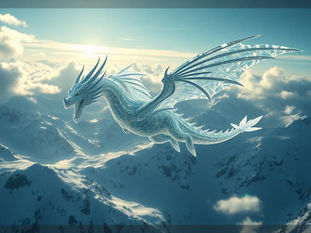
Craft Cinematic AI Video Prompts Quickly: A Simple Guide
May 3
5 min read
0
17
0

Creating stunning video scenes with AI tools is exciting. Tools like Kling AI are getting better all the time. But getting the exact vision from your head into an AI video can feel tricky. It all comes down to writing effective commands, also known as prompts.
A well-written prompt is the secret weapon for getting great results. It tells the AI exactly what you want in the scene, the action, and how the camera should move. This guide breaks down a simple structure for building cinematic prompts and shows you how to speed up your creative process.
Why Prompt Structure Helps Your AI Videos
Think of a video as having different layers. The main subject, what they are doing, the environment around them, any movement in that environment, and how the viewer sees it all through the camera. If your prompt is just a jumble of words, the AI might miss key details or combine things in strange ways.
Using a clear structure ensures you include all the important elements. This helps the AI understand your request better. The result? You get closer to your desired video output on the first try. This saves you time and reduces the number of generations you need to run, which can also save on credits.
Breaking Down the Cinematic Prompt Structure
A simple, powerful prompt structure includes five key parts. Listing these out makes sure you cover all the visual information the AI needs.
Subject
Start by describing the main person, object, or creature in your scene. Be specific about their appearance, clothing, or defining features.
Action or Movement
Next, describe what the subject is doing. Are they walking, sitting, looking at something? What specific action are they performing?
Background
Now, set the scene. Describe the environment. Is it a cave, a lake, a city street, a forest? Include details about the time of day or overall atmosphere.
Background Movement
Do you want anything in the background to move? This could be water rippling, clouds drifting, leaves blowing, or distant figures moving. Adding background movement can make the scene feel more alive.
Camera Motion
Finally, describe how the camera is viewing the scene. Is it still? Is it zooming in, panning across, tilting up, orbiting around the subject, or following them? Camera motion adds significant cinematic feel.
Let's look at an example from the video, combining these elements:
Imagine wanting a scene of a woman in a boat at night. Using the structure:
Subject: A young woman with flowing red highlighted hair sitting on the edge of a rustic wooden boat, her face illuminated by soft moonlight.
Action: She turns her head gracefully to look at the moon, her hair moving slightly.
Background: A calm lake reflecting the full moon, surrounded by dark hills, clear sky with stars and soft clouds.
Background Movement: Water ripples gently, faint clouds drift slowly.
Camera Motion: The camera orbits smoothly around her, keeping her face in focus.
Combine these descriptions into a single prompt. By thinking about each element separately, you build a complete picture for the AI.
Speeding Up Your Prompt Creation
While breaking down prompts makes sense, writing detailed descriptions like the one above for every video clip can take a lot of time. If you're creating many videos, writing prompts manually for each one can slow down your workflow considerably.
This is where tools designed to help with prompt generation become valuable. They can take a basic idea and structure it correctly or even work from an image to suggest prompt elements.
Simple Ways to Generate Prompts Fast
One way to speed things up is to use a template of the structure above and fill it in. You could even use general AI tools like ChatGPT to help you write descriptions for each section based on your ideas.
However, some tools are built specifically for this task. Imagine a tool that asks you simple questions about your desired scene, like uploading an image and specifying wanted action and camera movement. It then uses its knowledge of effective prompting to build the full structured prompt for you.
This kind of tool acts like a professional prompt engineer, taking your basic input (like an image of someone on a horse riding by a cliff) and your high-level ideas (horse galloping, camera following with a lift) and translating them into a detailed, structured prompt like the one described earlier. For anyone serious about creating lots of content efficiently, automating parts of the process like prompt generation is a game-changer.
Speaking of automation, automating other parts of your AI creation workflow can further enhance your output and speed. Check out the Midjourney Automation Suite from TitanXT. It's designed to automate and enhance your Midjourney experience, helping you generate more variations and organize your creations efficiently.
Putting it to Use: Example
The video showed how a specialized tool could take an image of a woman riding a horse by a cliff. The user simply asked for the horse to be galloping and the camera to follow while doing a gentle lift.
The tool took this input, analyzed the image, and generated a complete, structured prompt following the five-part method. When this prompt was used in Kling AI, the results were impressive. The AI captured the galloping horse, the rider's hair blowing, the camera following motion, and the subtle lift, delivering cinematic-style clips with minimal effort from the user.
While AI video tools are improving, getting consistent, high-quality results still relies heavily on the prompts you provide. Using a structured approach, whether building prompts manually or with assistance, makes a big difference.
Ready for More Efficient AI workflows?
Mastering AI content creation involves streamlining your process. From writing effective prompts to managing your generated assets, automation can play a key role.
If you're looking to enhance your current AI generation process, consider exploring tools that automate repetitive tasks and help categorize your outputs. The Midjourney Automation Suite from TitanXT is one such tool. It can help automate aspects of your creative workflow, allowing you to focus more on the artistic vision and less on repetitive actions.
See how automating parts of your AI art process can save you time and boost your productivity. Find out more about the Midjourney Automation Suite.
Getting cinematic results from AI video tools requires clear communication through your prompts. Breaking down your scene into key components – Subject, Action, Background, Background Movement, and Camera Motion – provides the AI with the detail it needs. And by using tools to help structure and generate these prompts, you can create compelling video scenes much faster than ever before.






